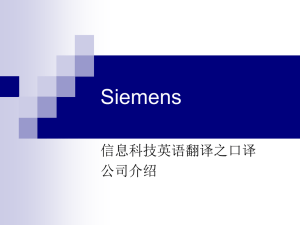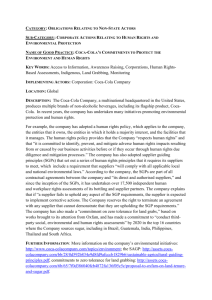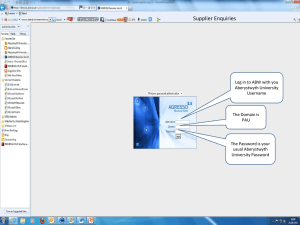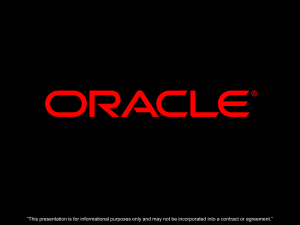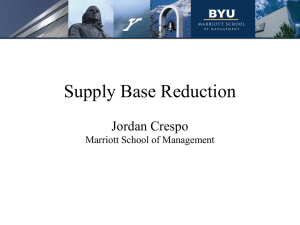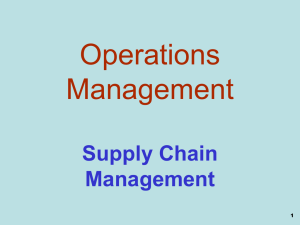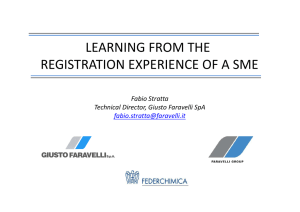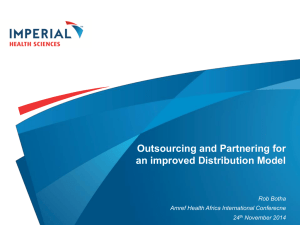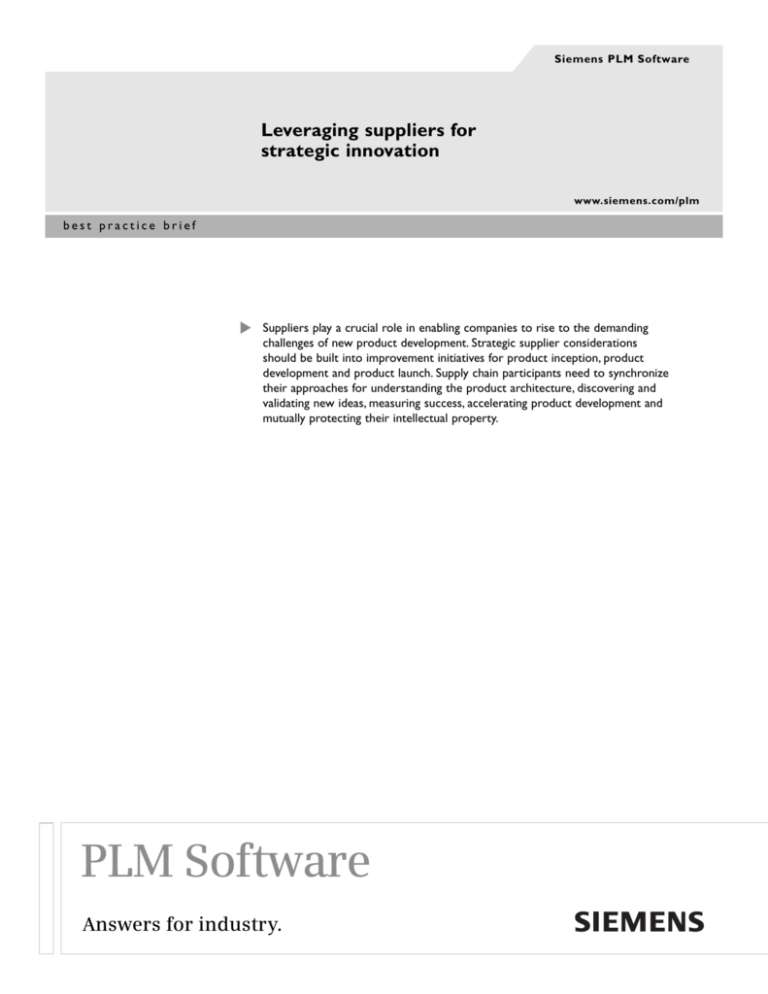
Siemens PLM Software
Leveraging suppliers for
strategic innovation
www.siemens.com/plm
best practice brief
Suppliers play a crucial role in enabling companies to rise to the demanding
challenges of new product development. Strategic supplier considerations
should be built into improvement initiatives for product inception, product
development and product launch. Supply chain participants need to synchronize
their approaches for understanding the product architecture, discovering and
validating new ideas, measuring success, accelerating product development and
mutually protecting their intellectual property.
PLM Software
Answers for industry.
Leveraging suppliers for strategic innovation
Table of contents
An overview to managing supplier
involvement
1
Supplier challenges in new product
development
3
Best practice solutions
5
Key Siemens solution capabilities
10
An overview to managing supplier involvement
The value of supplier involvement. According to recent studies, companies that
involve suppliers in the early stages of the product lifecycle (e.g., during design
inception) are able to reduce product development cost by 18 percent and improve
their time-to-market cycle by 10 to 20 percent.1
Reducing development costs and increasing production agility are key aspects that
determine the success of today’s new product development initiatives. If a product’s
cost structure is not supported by market-based pricing – or if development is not
flexible enough to meet customer needs, then the product’s margins and profitability
ultimately will suffer.
Best-in-class companies understand that suppliers play key roles in enabling them to
successfully implement their product visions. Current research estimates that 80
percent of a product’s cost is fixed by the time the design process concludes.With
this in mind, it is crucial that companies make correct sourcing decisions as early
as possible.
In brief:
Best-in-class companies understand that
suppliers play key roles in enabling them
to successfully execute their product
visions. Supplier integration is especially
important during early lifecycle stages
when companies need to address key
architectural, product definition, cost and
requirement issues.
Suppliers are able to influence systems technology that directly relates to a product’s
functional architecture, product structure, cost structure and ultimately to customer
requirements.To understand product costs and ensure production flexibility,
companies need to know:
• What technologies a supplier can offer
• How these technologies map to the product’s content and cost structures
• How these technologies relate to customer requirements
• How supplier availability relates to the wider product launch
Studies by AMR Research2 and the Aberdeen Group3 indicate that 12 percent of
today’s manufacturers integrate their supply chain partners into the design process
prior to prototype development.The good news is that companies are beginning to
understand the need to better align their design and procurement processes – and
are responding appropriately.The cautionary news is that a “beginning” is far less than
total mastery.
Much has been written about how to best leverage outside expertise in general
terms.The scope of this brief focuses on the detailed role that suppliers can play with
respect to new product development. Additional Siemens PLM Software best practice
briefs focus more precisely on the tactical details of procurement.
Suppliers and new product development. Strategic supplier considerations need
to be built into new product development initiatives in three key areas: product
inception, product development and product launch.
Typically, new product introductions are measured by the success of their launches
(often expressed in terms of units sold). However, product launches involve crossfunctional business processes, whose successful execution demands close
collaboration between organizations responsible for defining market demand,
designing the product and supplying/servicing the customer. Ultimately, the supporting
infrastructure for these processes is defined by technology decisions made early in
the product development cycle.
1
Companies make key infrastructure decisions by deciding where to prioritize their
technology needs and how to make their technology investments.This strategic
thread has to be closely managed throughout the development cycle – up to the
supply/delivery stage when technology is incorporated into the final product.
Apple’s work on their iPod product illustrates a successful and highly visible example
of strategic supplier interaction. Like other digital music players, the iPod offers an
intricate combination of powerful branding, slick marketing, attractive design, fast
electrical components, a robust mechanical structure and simple operating software.
However, one of the areas where iPod changed the competitive landscape was its
coupling with iTunes and ultimately with the entertainment companies that supply
music.This combination of hardware, software and content represents a unique value
chain. Music lovers were suddenly encouraged to legally and affordably purchase music
for their digital players.This supplier relationship not only ensures the availability of
content for users, but also facilitates the strategic sourcing of hard drives and
flash memory.
Other successful examples of closely managed supplier relationships include IBM with
its integrated product and development processes, Proctor & Gamble with its internal
connect and development strategies and Dell who has become the poster child for
supply chain management.
Strategic supplier relationships. The following organizations have a vested
interest in most strategic supplier relationships.
Participant
Role
Product management
and marketing
Outlines the core concepts that underlie the product’s
ideas; typically responsible for providing a base
framework for ensuring the product’s success including
outlining what capabilities need to be sourced
Procurement
Manages strategic supplier relationships, including the
quote and bid process for new initiatives and the
coordination of communications between suppliers and
rest of the product development team
Engineering design
and development
Ultimately responsible for designing the product,
bringing multiple subsystems together and validating
system performance against established product
requirements
Manufacturing engineering Responsible for ensuring that quality goals are met,
including compliance of supplier-provided components,
parts and subsystems
Production engineering
2
Responsible for ensuring that production quantities can
be reliably delivered and that supply chain production
issues have been addressed for product launch
In brief:
Apple’s work on iPod illustrates a successful
and highly visible example of strategic
supplier interaction. Apple's ability to
establish a unique value chain plays a major
role in distinguishing iPod from competitive
product offerings.
Supplier challenges in new product development
AMR Research’s recent report on the perfect launch interviewed more than 20
manufacturers across multiple industries to determine what challenges they faced in
launching new products.While these challenges touched many parts of their business,
successful manufacturers recognized the need to balance three primary business
domains: demand, product and supplier execution.
Challenges facing 3 key business domains
Demand
Supply
Product
Lifecycle demand
variability measures
Supply network design
Design prioritization
Price optimization
Supply cost and
management
Speed and control of innovation
compliance
Channel promotion
and sales strategy
Phase-in and phase-out
of material
Resource allocation
In brief:
Successful manufacturers recognize the
need to balance three primary business
domains.These domains have to
synchronize their assumptions,
responsibilities and performance to
facilitate the perfect product launch.
As might be expected, companies that expect to balance the above considerations
require a mechanism for synchronizing the performance of these domains’ product
development responsibilities. At the end of the day, this means that sustainable
product success depends on the ability to integrate product design with its related
demand and supply management processes.
While outlining the right production quantities is important to this process, it is also
imperative that companies tie their supply management needs to their product
definitions and product structures. Unfortunately, this level of holistic cooperation is
often missing from many supplier relationships.
The following table describes typical problems that make it difficult to synchronize
the needs of the demand, supply and product domains.
3
Section name
Common synchronization problems4
Issue
Why it matters
Unstructured discovery
and ideation processes
Most manufacturers have a fragmented knowledge
management and prioritization process, where it is
difficult to identify what ideas have risen to the level of
ideation validation.While this is a common lifecycle
problem, it is generally not advisable to bring suppliers
into the prioritization process.
Speed of innovation
and iterative design
Bottlenecks within the design process itself are often
caused by collaboration problems across the wider
supplier-integrated development cycle.These bottlenecks
limit product development’s ability to speed creative
innovation within a scheduled timeframe.
Validating demand
and supply
While many manufacturers have a defined validation
process, the challenge is to integrate the validation of
customer alpha-beta pilot test and supplier process
capabilities as the design evolves.
Channel readiness for
sales and service
Delivering documentation and training to the sales
channel usually is a last step and is often underestimated,
thereby affecting expected revenue uplift and sustainment
of the product launch.
Global rollouts beyond
initial regions
While many manufacturers succeed in local product
launches, they struggle to repeat their success globally
(typically because they are unable to successfully
integrate suppliers in other locales).
Measurement’s lack
of enforcement
Even when measures are in place, manufacturers rarely
close the loop with corrective actions, leading to a lack
of accountability and encouragement for wrong
performance.
4
In brief:
Companies struggle to synchronize their
demand, product and supply domains in
six crucial areas, including:
• Ideation and early prioritization
• Iterative design
• Product validation
• Sales/service support
• Global rollout
• Corrective feedback
Best practice solutions
Leading manufacturers employ numerous best practices to alleviate pain, mitigate risk
and ensure product success, including the practices outlined below.
Disciplined product management, road mapping and rationalization. The
infrastructure for the supply process is ultimately defined by technology decisions
made early in the product development cycle. As outlined by the Product
Development and Management Association (PDMA), the core product architecture
needs to be mapped to each company’s strategic direction, core customer needs and
technology evolution.5
This approach allows companies to strategically understand which pieces of the
product architecture are crucial to meeting customer and market needs. It also leads
to a clear understanding of what critical lifecycle capabilities require focus. Over time,
this understanding will evolve as new technologies and changing needs arise. Managing
this process to ensure a company’s best strategic fit is a core element in enabling
successful manufacturers to excel at meeting market demand.
In brief:
Industry-leading companies employ best
practices to:
•
•
•
•
•
•
•
Define their product architectures
Identify strategic sourcing partners
Forecast product demand
Integrate their S&OP processes
Validate CTQ measurements
Share product information
Secure their intellectual property
“Designing in” agile and flexible supply networking. After a company defines
its product architecture, it can map its core competencies against the market’s
primary drivers. Once this is complete, companies are able to understand which
competencies should be kept in house and which should be outsourced to suppliers.
Companies can leverage their product development expertise to outline their
products’ systems and subsystems and maximize production flexibility in terms of
quantities, location and supplier participation.These decisions are crucial to PDMA’s
core ideas for lean launches and postponement strategy.
The PDMA lean launch method requires flexible supply chains capable of rapidly
responding to early sales indicators, as well as the ability to minimize inventory
commitment during product rollout.
A postponement strategy that influences time or form plays a key role in driving a
lean launch.Typically, companies adopt a postponement strategy so that they can delay
product finalization until the last possible moment.
Time postponements delay inventory deployment and minimize distribution volumes by
only shipping exact quantities to meet precisely defined customer requirements. In
contrast, form postponements leverage product variations so that companies can
flexibly meet specific market requirements. Along these lines, product options – such
as assembly, packaging and labeling – are left open until customer orders actually arrive.
Dell is a recognized master in time and form postponement whose strategies have
transformed the personal computing industry. As real-world examples indicate, these
processes require companies to “design in” their lean launch and postponement
options to the product definitions and manufacturing processes established by their
product marketing and procurement teams.
Strategic partner identification, mapping and management. Once companies
outline the core product concept and define the intended delivery mechanism, they
can research and identify the partners and suppliers who are most able to meet their
strategic program needs. Ideally, procurement teams should be able to provide
supplier profiles that identify sources for specific components, subsystems and systems.
5
These profiles typically include details about the supplier’s product and capabilities, as
well as strategic business information, such as the supplier’s mission, goals, stability,
location, market size and project history. By taking all of this information into account,
companies should be able to determine whether a given supplier provides a strategic
fit with their long-term vision and market aspirations.
Effective demand forecasting. As indicated earlier, companies that synchronize
the demand, product and supply domains are well positioned to perform successful
product launches. Along these lines, companies need to ensure that OEM-supplier
business agreements are based on realistic sales forecasts.These forecasts are crucial
as the product launch draws near and companies have to make sure that production
availability matches market demand.
Common forecasting techniques (PDMA)
New product
forecasting
techniques
Judgmental
methods
Quantitative
Executive
opinion
Attribute
Casual/regression
modeling
Time series
Concept
testing
Others
Sales force
composite
Trend line
analysis
Linear
regression
Expert
systems
Product use
testing
Scenario
analysis
Moving
average
Nonlinear
regression
Neural
networks
Market
testing
Normative
Exponential
smoothing
Logistic
regression
Simulation
Pre-market
testing
Exploratory
Looks like
analysis
Event
modeling
Delphi method
Assumptions-based
modeling
Diffusion
modeling
ARMA/ARIMA
AMR Research’s studies on new product development forecasting indicate that
companies who are able to sense channel demand changes quickly (i.e., in less than
one week) have twice the new product success as companies that take two weeks or
more to reach this conclusion.6 AMR Research also found that 56 percent of
companies who participated in the study were unable to sense demand changes as
fast as the best practice companies.
Both AMR Research7 and PDMA8 conclude that demand sensing needs to be based on
attribute-based forecasting – ideally derived from customer pilots, previous sales
history and close market analysis.This forecasting outlines potential sales by asking
respondents to evaluate product attributes, including key product capabilities, design
variations, packaged accessories and service/warranty plans.
6
In brief:
Companies need to ensure that OEMsupplier business agreements are based
on realistic sales forecasts. Best-in-class
companies are distinguished by their
ability to sense demand changes quickly
and apply attribute-based forecasting
methods.
Ideally, these attributes should be mapped back to the product architecture defined
by product management, as well as to key market segments that can be monitored
closely. Market demand requirements should be shared with suppliers as early in the
product lifecycle as possible to allow them to adjust their inventories.
Companies need to carefully assess market size and map this to their launch size
(e.g., to make certain that they have enough inventories to meet market demand
without having their warehouses full of products they cannot sell).
Relationship between market size and market demand (PDMA)
In brief:
Companies need to carefully assess market
size and map this to their launch size.
Providing too much or too little inventory
jeopardizes a company's ability to maximize
product sales while minimizing operational
cost.
Launch size
Actual market size
Low
High
Low
Commercial failure
Opportunity cost
High
Cost overrun
Commercial failure
Commercial success
The requirement for closely monitoring demand and sharing time-critical results is
the driving motivation behind the use of radio frequency identification (RFID) tags in
demand sensitive industries.
Integrated sales and operations planning processes. Recent studies find a
strong correlation between how long an organization has had its sales and
operations planning (S&OP) initiatives in place, how well the initiative’s sales,
marketing, operations and network supply partners coordinate their functions and
the success of a company’s new product development processes.9
While planning across these groups is essential, it must be followed up by close
monitoring. Equally important, all of these groups need to understand, approve and
orchestrate the S&OP plan.
Continuous market and supply chain validation for CTQ measurement.
Ensuring that delivered products meet the needs of the customer is in the best
interest of both OEMs and suppliers. Before product development begins, the OEM
and its suppliers need to agree on critical-to-quality (CTQ) measurements that are
required to meet market demand. CTQ measures must include the actual
measurements themselves, their related goals and actions and the expected
consequences that will occur if these standards are not met.
CTQ evaluations need to be performed at specific stages in the development cycle,
including during system definition and validation, prototyping, detailed development,
manufacturing and production.
Single source of product information. It is imperative that product teams work
together throughout the development cycle.Work on externally sourced
components and subsystems need to be part of the same workflows and signoff
procedures as internally developed design elements.
7
To do this effectively, companies need to maintain a single product definition. A single
source of product information that minimizes communication breakdowns is essential
for meeting this requirement.This is particularly true for companies that provide
complex products requiring multiple manufacturing processes and seamless supply
chain interactions.
A shared product definition also promotes joint agreements on common work
practices, collaboration procedures, work breakdown structures and common IT
infrastructures.These issues ideally should be included in supplier agreements to
facilitate a distributed – yet integrated – development approach.
Secure and effective intellectual property management. Given the
competitive nature of today’s global economy, it is imperative that companies protect
their intellectual assets and capabilities. By evaluating a variety of case studies, AMR
Research has identified five specific ways to effectively protect today’s most valuable
intellectual property.
Keys for protecting intellectual property
Best practice
How the practice works
Choose complementary
partners
Companies should select partners and suppliers that
complement their business strategy. Choosing partners
that have competing aspirations is counterproductive
over the long term, especially when jointly developing a
project’s intellectual property.
Mutually honor intellectual property interests
Companies can foster partner collaboration by letting
their partners and suppliers build their own intellectual
property. Implementing complementary intellectual
property and maintaining that differential bonds partners
together.
In addition, since many partners will want to maintain
their own IP protections, it is important to honor these
requests.The best way of mutually protecting everyone’s
intellectual property is to establish legally binding nondisclosure agreements.
Facilitate selective
information access
Companies should provide their partners and suppliers
with access to their intellectual property on a need-toknow basis. Partners should only have access to their
particular piece of the IP puzzle (e.g., by using design
models that do not need a complete history tree).
Define/protect
keystone property
Companies should define keystone portions of their
intellectual property and guard it within their own
organizational and technological borders.This requires
companies to understand what intellectual property is
strategically crucial, map it out for special protection
and keep it safe.
Limit full access
Companies should limit the number of people who are
entitled to have full access to their intellectual property.
8
In brief:
Given the competitive nature of today’s
global economy, it is imperative that
companies protect their intellectual assets
and capabilities. Companies need to make
certain that they:
• Select compatible partners
• Honor everyone's property interests
• Limit information access on a need-toknow basis
• Institute organizational and technical
security provisions
• Tightly restrict full access
Process management. Successful companies are taking their lead in process
management by leveraging the Six Sigma process improvement methodology.This also
provides a starting point for companies that want to improve their product
development processes. As outlined by AMR Research, the following Six Sigma
improvement steps are commonly adopted.
• Define, where companies characterize the goals for their integrated sales and
operations planning (S&OP) processes
• Measure, where companies establish and monitor their success metrics
• Analyze, where companies identify the potential causes of failure
In brief:
Companies and their suppliers must agree
on formal success measures both before
and after product launch. Everyone needs
to understand the product's CTQ goals
and what corrective actions and consequences will apply if these objectives are
not fully met.
• Improve, where companies prioritize their best practice and technology investments
to correct failure modes
• Control, where companies institutionalize their processes with measurement
and control
Companies and their suppliers must agree on their formal success measures before
product launch, as well as after launch to ensure necessary corrective actions.These
measures should be based on agreed upon CTQs with goals, specific corrective
actions and noncompliant consequences explicitly defined.
9
Key Siemens solution capabilities
Siemens PLM Softare is the leading global provider of product lifecycle management
(PLM) software and services with 5.5 million licensed seats and 51,000 worldwide
customers. Siemens’ approach to supplier relationship management recognizes the
link between strategic sourcing and product development.
Siemens’ digital lifecycle management solutions enable companies to establish a single
source of product data that they can use for collaborating with their suppliers.This
single source of information helps companies enforce and synchronize common work
practices that pertain to the inception, review, approval and manufacture of internally
and externally sourced components.
Companies can complement this readily adaptable foundation with a range of
collaboration capabilities they can use to enable OEMs, suppliers and partners to
interact with each other more effectively.
At the base level, Siemens-driven PLM solutions enable diverse manufacturing
enterprises to seamlessly share information without regard to the applications being
routinely employed by the supply chain’s various participants. As a result, suppliers are
able to maintain close relationships with their respective OEMs while continuing to
protect their own intellectual property.
By using Siemens’ Teamcenter® software – the de facto standard for PLM deployment – to build this PLM foundation, companies can extended their enterprise so
that individuals, product teams, project managers, suppliers, allied partners and
downstream lifecycle participants can exchange information and ideas in automated
workflow-driven processes.
These Teamcenter capabilities facilitate visual product collaboration, where OEMs and
suppliers share complex information as it evolves across all of its lifecycle stages.
Teamcenter also provides supplier relationship management capabilities that combine
e-sourcing, analytics, knowledge management and collaboration technology to
establish a single source of product, process and sourcing information for all supply
chain stakeholders.
Siemens is uniquely positioned to fuse this technology into supplier relationships that
companies can use to improve the cost effectiveness of their procurement initiatives,
as well as increase the innovation and collaboration capabilities of their domestic and
offshore product development operations.
Teamcenter addresses classical sourcing needs, such as supplier identification, supplier
assessment and sourcing negotiations. Companies can also use Teamcenter to
automate extended processes that drive key supplier relationships, including quality
monitoring, engineering change, intercompany teaming, supplier training, engineering
services support, joint project management, issue tracking and performance
monitoring.
Companies can leverage Teamcenter’s modular set of sourcing capabilities by directly
linking this technology into their product development processes. Each module in the
Teamcenter suite supports a key step in the strategic sourcing process, including:
• RFP and sourcing surveys, which support the automatic distribution of RFPs and
surveys, easy online questionnaire completion, automated supplier communications
and rapid response analysis.
• Spend management, which tracks enterprise spending and compliance by
business unit, supplier, location, commodity and diversity supplier classifications.
10
In brief:
Teamcenter addresses classical sourcing
needs, as well as the extended processes
that drive key supplier relationships.
Teamcenter sourcing capabilities can be
leveraged to improve:
• RFP processes
• Supplier-related spending
• Auction-driven bid processes
• Sourcing community collaboration
• Supply chain management
• Auctions, which bring the negotiation process online while enabling bidding on
both price and nonprice components.
• Sourcing community, which provides a collaborative project-driven workbench
with sourcing tools and resources that can be used to “market” deals, capture/share
sourcing knowledge and manage sourcing projects.
• Supplier management, which enables companies to identify, engage and evaluate
their suppliers; the module also facilitates supplier self-registration.
Companies can extend Teamcenter’s open PLM framework to link their demand,
product and supply domains and enable marketing, product development, production
and manufacturing teams to work together in concert.This approach lets teams
perform everyday tasks using familiar tools they already understand; behind the
scenes,Teamcenter brings these domains into a single seamless, highly productive
value chain.
In brief:
Companies can extend Teamcenter’s open
PLM framework to link their demand,
product and supply domains.Teamcenter
brings these domains into alignment by
enabling extended value chains to:
• Capture diverse product knowledge
• Share/exchange this information globally
• Inject this information into automated
workflow-driven product development
processes
Teamcenter enables widely dispersed teams to capture knowledge from multiple
applications and authoring systems and integrate this information into combined
product definitions.Teams also can leverage Teamcenter to plan and manage lifecycle
projects on a real-time basis and link project information and program controls into
Teamcenter-managed product development workflows and review/approval
procedures.
Teamcenter is adept at enabling companies to increase the value of their product
knowledge by managing diverse forms of intellectual property on an enterprise basis –
and allowing this knowledge to be leveraged across multiple programs and revenuegenerating initiatives.
Key Teamcenter capabilities
Capability
How Teamcenter provides value
Linking demand, product
and supply domains
Enables companies to manage their lead tracking
efforts and provide product development with
immediate customer and sales feedback
Provides a free-thinking and collaborative environment
where ideas can be encouraged, gathered, shared and
discussed among a company’s own organization, as well
as between its suppliers, partners and customers
Supports collaborative decision making by enabling
promising ideas to be investigated, evaluated, compared
and communicated
Provides real-time capabilities to facilitate the rapid
formation of sourcing teams, concept studies, program
reviews, design reviews and engineering change reviews
Provides a framework of lightweight planning and
execution tools to ensure that the whole enterprise is
able to support a company’s marketing and sales activities
11
Key Teamcenter capabilities
Capability
How Teamcenter provides value
Capturing knowledge for Enables development teams to integrate combined
integrated product
product definitions into their engineering process
definitions
management solution; supports all lifecycle stages
ranging from concept design through engineering,
initial sourcing, manufacturing and ultimately
maintenance, repair and overhaul
Provides comprehensive change and validation
management capabilities
Enables companies to integrate supplier processes and
other collaboration activities into their own design
process; facilitates the management of complex product
configurations and the ability to make manufacturing
decisions during the design cycle
Managing lifecycle
projects
Enables companies to create, maintain and monitor
complex project schedules
Enables project and program managers to define
projects in terms of work tasks, related costs, resource
requirements and needed skill sets
Highlights the current status of all projects and their
related teams through the use of dashboards, email
and pop-up notifications and other event-related
communications
Extending information’s
value to the
enterprise level
Captures information and intellectual property
generated by diverse applications and authoring
systems
Facilitates robust price discovery and cost transparency
throughout all lifecycle stages
Enables product information to be shared in a
distributed or federated multi-site environment by
leveraging secure repositories that can be controlled,
accessed and audited
Protects the PLM environment’s underlying systems and
databases from unauthorized access and use; defines how
individual pieces of information can be used
Ensures the protection of web-based information
across firewall boundaries through the use of security
features and standard HTTPS protocols
Controls user access and intellectual property rights by
applying security clearances and enforcing entitlements
that pertain to individual users, user roles, teams,
groups and projects
12
Footnotes
Procurement in New Product Development, Jim Brown,The Aberdeen Group, Inc., 2005
The CIO’s Guide to the Perfect Launch:Translating Innovation into Business Benefit, Michael J. Burkett, Eric
Karofsky and Joyce McGovern, AMR Research, 2005
3
Op cit, Brown,The Aberdeen Group
4
Three Supply Chain Actions You Can Take Today to Improve Your Product Launches, Lora Cecere, AMR Research,
2006
5
The PDMA Handbook of New Product Development, Second Edition, Kenneth B. Kahn, George Castellion,
Abbie Griffin, 2005
6
Op cit, Cecere,Three Supply Chain Actions
7
Case Study on Forecasting New Product Introductions:Three Techniques to Consider, Lora Cecere, AMR
Research, 2006
8
Op cit, Kahn, Castellion, Griffin
9
Op cit, Burkett, Karofsky, Griffins, AMR Research
1
2
13
About Siemens PLM Software
Siemens PLM Software, a business unit of the Siemens Industry
Automation Division, is a leading global provider of product
lifecycle management (PLM) software and services with nearly
six million licensed seats and 56,000 customers worldwide.
Headquartered in Plano, Texas, Siemens PLM Software works
collaboratively with companies to deliver open solutions that
help them turn more ideas into successful products. For more
information on Siemens PLM Software products and services,
visit www.siemens.com/plm.
Siemens PLM Software
Headquarters
Granite Park One
5800 Granite Parkway
Suite 600
Plano, TX 75024
USA
972 987 3000
Fax 972 987 3398
Americas
Granite Park One
5800 Granite Parkway
Suite 600
Plano, TX 75024
USA
800 498 5351
Fax 972 987 3398
Europe
3 Knoll Road
Camberley
Surrey GU15 3SY
United Kingdom
44 (0) 1276 702000
Fax 44 (0) 1276 702130
Asia-Pacific
Suites 6804-8, 68/F
Central Plaza
18 Harbour Road
WanChai
Hong Kong
852 2230 3333
Fax 852 2230 3210
© 2009 Siemens Product Lifecycle Management
Software Inc. All rights reserved. Siemens and the
Siemens logo are registered trademarks of Siemens AG.
Teamcenter, NX, Solid Edge, Tecnomatix, Parasolid,
Femap, I-deas and Velocity Series are trademarks
or registered trademarks of Siemens Product Lifecycle
Management Software Inc. or its subsidiaries in
the United States and in other countries. All other
logos, trademarks, registered trademarks or service
marks used herein are the property of their
respective holders.
www.siemens.com/plm
8/09

